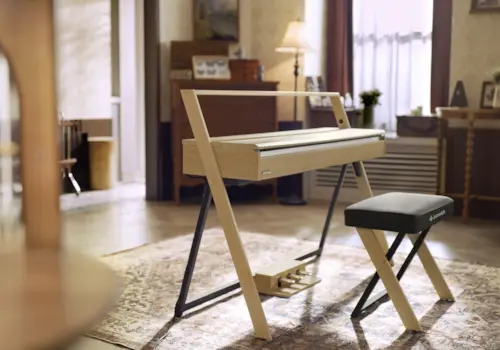One of Rachmaninov’s more understated preludes, this piece will need careful shaping and refinement of the left hand above anything else, says Lucy Parham

Don't have the score? You can download the full piece from our Scores store, here.
This gem of a Prelude held a very dear place in Rachmaninov’s heart. He composed it just after the birth of his first daughter. The work contains a sense of profound tenderness and love, so it is very important to convey this in the overall mood.
The piece has always been special to me as well. My mother was a good pianist and I remember her playing it when I was very young, so it has been part of my musical life for many years.
Don’t be deceived by its appearance. It may look fairly simple and manageable but I can assure you that it’s not. The most difficult challenge is the LH part. It is tricky to master because it wanders constantly, weaving in and out, and for that reason it is crucial that you first master the LH alone.
The pedalling is also quite a challenge. I would suggest you pedal with your ear but generally less is more as you do not want to be bathed in the sound. Equally, it is vital to keep the bass notes within the pedal as much as possible.
TIP 1: How to nail the opening
The key is E flat major, which is one that represents warmth. The piece begins with a fairly simple phrase, played in the RH, that is then elongated into a longer phrase. Bars 1 and 2 give us the first utterance of the Prelude’s three-note ascending motif. As you are trying to convey a sense of intimacy, try not to over-project in the first few bars. Rather, almost try to hold back, as if you were sharing a private thought.

Bars 1-2
You will notice a small hairpin crescendo in the second bar. This crescendo should actually be focused on the LH semiquavers. Rather than making this a large crescendo, try to shape the line accordingly.
In bar 4 the RH needs a projected, steely fifth finger. Make sure that all the four notes in these chords sound. I would suggest practising without the thumb here to help you grip the other notes. You need to shape and prepare each chord so that it sounds smooth and legato at all times.
In bars 5 and 6 the melody is elaborated and extended. This is the second time we hear it, so you can afford to open up and project. You are aiming towards the first small climax, which arrives at bar 8. However, it is only mf, not f, so leave something for later!
The rolled LH chord at the start of bar 8 needs to sound elegant.

Bars 7-8
Try not to grab it – think of the LH as a harp as you roll the chord. The following LH semiquavers again should adhere to the hairpin crescendo; they are as equally important as the RH. Grade the diminuendo as beautifully as you can and melt into the beautiful G minor chord at the start of bar 9.
None of the tone at this point should sound forced. Try to think of it as warm and enveloping. The main aim is to keep the tone focused on the RH’s fifth finger while balancing it with the LH semiquavers. There should be the feeling of a duet between the two hands, with both being of equal importance.
TIP 2: At bar 14 you need to think about the long sweeping line that follows
The line will take you all the way up to bar 20, and it can be quite challenging to grade it and not arrive at the high point too soon. In order to help, always think over the bar line (Rachmaninov’s clever phrasing ensures the melody does not stop abruptly). Think as a singer and breathe with your phrasing.

If you are ever in doubt about the phrasing I would suggest you play the LH alone, and sing the RH. You will naturally phrase it as a singer would. Then reintroduce the RH and try to imitate what you have just sung.
A good example of needing to get over the bar line is between bars 18 and 21. Bars 18 to 19 should be knowingly played without any stopping or starting. In bar 19 it is important to observe the small accents in the RH, which should be weighted but not forced, but should continue to gain in strength to the top C in the middle of the bar. The chord in the middle of bar 19 needs to have a real sense of space and breadth. Don’t grab at the LH and make the most of the triplets, so that each one has a melodic value. This bar is one of only two forte moments in the whole piece, so it has a very special significance.

Bar 19
TIP 3: Highlight and shape the melody as we approach the middle of the piece
The tension in the chord at the beginning of bar 20 is palpable!

Bars 20-22
It’s a heart-rending moment and therefore needs to be played with great tenderness and emotion. Sink into the F octave in the bass, particularly focusing on your fifth finger. From there you need to subside until you reach bar 21; this answering phrase ends the first half of the piece.
Notice how Rachmaninov puts an accent under the middle notes in bars 21 and 22. This inner melody needs to be beautifully highlighted and shaped. Again, the voicing here is something that takes some considerable practice, but it definitely pays off.
TIP 4: How to interpret the return of the main theme
Bar 23 brings the return of the main theme. Now, however, it is in a different register of the piano, portraying a more unsettled mood. Follow the RH’s alto thumb line until bar 27 – this line provides a beautiful counterpoint to the melody. The LH is also harmonically significant.
An exquisite diminuendo takes place between bars 26 and 28. Melt into the LH spread chord at the beginning of bar 28 and again focus on the RH finger as well as the conversation between the melody and the LH quavers.

Bar 28
TIP 5: Bring out the conversational tone from bar 32
The alto line is prominent in bar 32. This bar has a lamentoso feeling to it, so try to sink wearily into the accents. Both the alto and the tenor parts are descending in unison at this point. The following few bars should feel like a conversation, paired with a certain improvisatory feel. The alto is just as important as the soprano and the tenor lines, so make sure you judge how you want to balance them.
Now there is the sense that the piece is beginning to ebb away. Before this happens, though, there is the final crescendo to bar 37. This is the second of the two fortes; it is the final climax from which the performer needs to gradually fade away.
TIP 6: Take your time as you approach the end of the piece
The final five bars should feel as if they are gradually floating away like gossamer. Every note needs to be beautifully weighted – but without any lumps in the phrasing. Equality is key here, and even if not marked, try for a tiny little crescendo hairpin at the top of bar 41 – this will give you something from which to disappear.

Bars 40-41
Take your time towards the end of the penultimate bar. Make the most of the ritardando marking and indulge in the long Eb spread chord, placing your LH over your RH in order to play the final note. Lift the pedal slowly (and carefully) for the perfect finish!
This article is taken from Pianist 122, available here.








